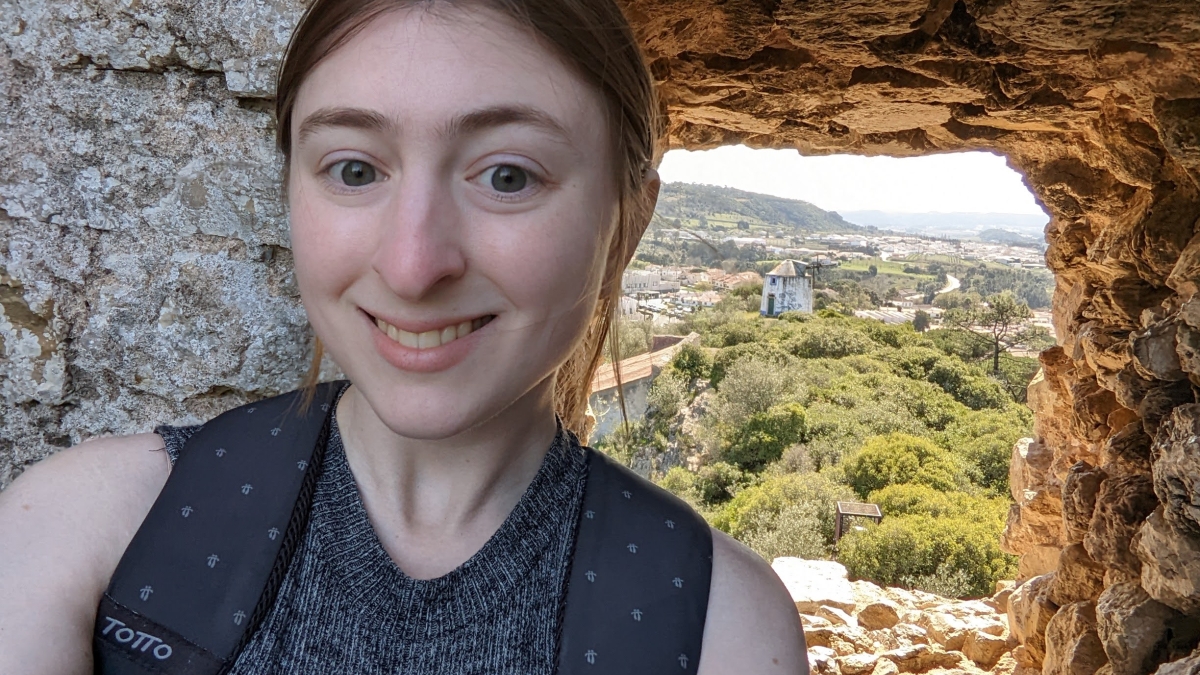Online global health program empowers FEMA employee

Autumn Coalwell during a volunteer event removing invasive species in Maine with a view from the top of the trail. Courtesy photo
Looking for a flexible, reputable degree program with a subject matter that applied to her career was important for ASU Online student Autumn Coalwell.
Coalwell works full time as a program analyst and contracting officer representative for the Federal Emergency Management Agency (FEMA). She is also enrolled in the global health 4+1 program through the School of Human Evolution and Social Change, and is minoring in political science.
The accelerated 4+1 program offers students both a bachelor’s and master’s degree in just five years.
“I didn’t do my degree right out of high school,” Coalwell said. “I went and did the AmeriCorps national service program.”
“When I went to finish my degree while I was working with FEMA, I needed something that would work well with my full-time work schedule because it just wasn’t feasible for me to take time off to do my degree. Especially when I would also have to be paying for the degree.”
ASU News spoke with Coalwell about her experience in the global health program and her work with FEMA.
Editor's note: Answers have been edited for length and clarity.
Question: Tell us about your career with FEMA.
Answer: I’ve worked with FEMA for about six years. I started with the AmeriCorps NCCC FEMA Corps program, and then I worked as a FEMA reservist, which is when you’re employed part time throughout the year, but you deploy into the field in direct support of disasters.
After that, I obtained a job with headquarters as a program analyst and contracting officer representative.
A program analyst is someone who administratively and strategically supports FEMA’s programs. I work on a wide range of tasks, such as the development of new training and mentorship programs for the workforce, the evaluation of existing programs and the development of program guidance documents. A contracting officer representative (COR) is a member of the agency who manages contracts for services or goods. So I help plan, write and manage contracts.
Q: When you worked in the field for FEMA, was there a location that made a significant impact on you?
A: Most of my time deployed to the field was spent in Puerto Rico working with the FEMA Individual Assistance Program, which helps individuals through the recovery process.
Something that really stood out to me and has stayed with me was the situation of homeownership in Puerto Rico. Several generations ago, many people in Puerto Rico built homes on land that, at the time, had no ownership. The government of Puerto Rico allowed these homes and settlements to be built.
Over the years, these homes were passed down through families. When Hurricane Maria hit and many of these homes were destroyed, the families were unable to prove ownership of their homes to seek response or recovery assistance.
Even though they had grown up in these homes, their grandparents had built the homes and the building of these homes was not considered immoral or illegal at the time they were built, these families were left homeless. They could not prove that they were owners or renters. They had no avenues to seek repair or temporary housing assistance. This shocked me, and since then, I have learned of other similar situations around the world.
Q: How do you hope your degrees in global health will help you in your career at FEMA?
A: It already is helping with my career at FEMA, mostly because of the understanding of social and cultural differences. Even here in the United States, we have such a wide range of cultures and social differences around the country.
When you are operating in disaster response and recovery situations, you’re encountering a lot of the social determinants of health that are discussed in the global health program.
Understanding how to really help communities with recovery and resilience is important. A lot of those factors and considerations are recurrent in the global health major, so I really think that it’s applicable. I also hope to get into some international affairs work in the future.
Q: Has there been a professor or course that has made a big impact on you?
A: The class ASB 327: Disaster!, taught by President’s Professor Amber Wutich, was great. It was so much more than I expected. I’ve taken a lot of emergency management classes in the past and they really just revolved around policies within disaster response within the U.S. This course really dove into a lot of the ethics surrounding humanitarian relief and disaster response — and how those efforts and how humanitarian aid can be used to promote resiliency instead of just the immediate needs of the community and the importance of long-term development and recovery.
Several other professors have made a profound impact on my degree through their engaging teaching methods. They include Gabriela Clarke, graduate teaching associate of Spanish at the School of International Letters and Cultures, and Charles Ripley, instructor at the School of Politics and Global Studies.
More Sun Devil community

ASU wide receiver Xavier Guillory driven by faith, family and heritage
It’s a few minutes into the Zoom call when Arizona State senior wide receiver Xavier Guillory is asked about his father.He looks…

Our photographers share their favorite photos of 2024
Photos can tell a story in ways that words sometimes can't, capturing the action, beauty and emotion of the moment. And as we…

How Kenny Dillingham remade ASU's football team in just 1 year
When Arizona State University football coach Kenny Dillingham went about rebuilding his roster after a 3-9 season in 2023, the…